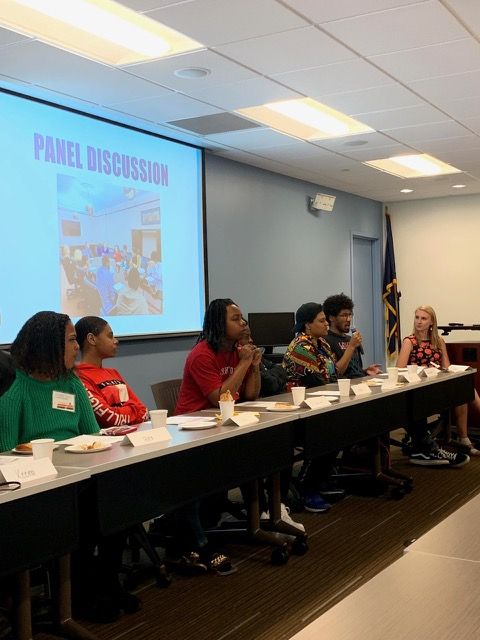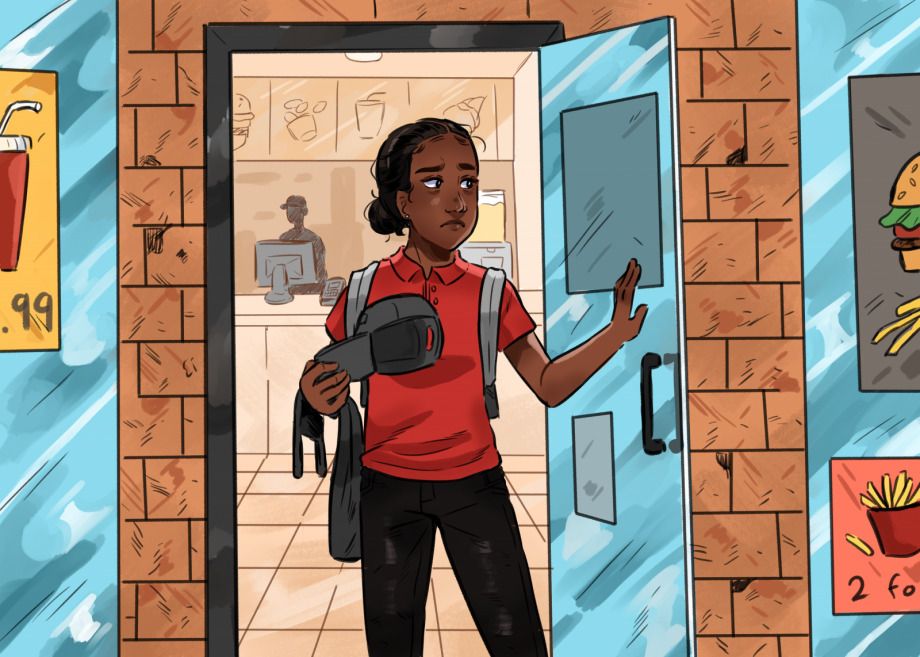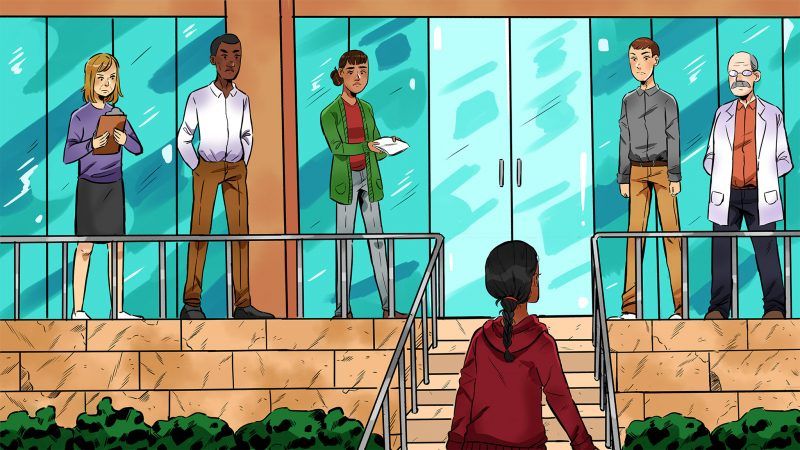Are You A Vanguard? Applications Now Open
In interviews with young people who have experienced homelessness, common themes emerged. One young man, Jasir, describes a constant search for trustworthy allies, in the streets and among the professionals tasked with helping him. Like Miracle, he, too, rode the SEPTA trains for many hours when he did not have a home.
This is your first of three free stories this month. Become a free or sustaining member to read unlimited articles, webinars and ebooks.
Become A MemberEDITOR’S NOTE: This story is part of the “Our Kids” reporting project. Our Kids is a project of the Broke in Philly reporting collaborative that examines the challenges and opportunities facing Philadelphia’s foster care system.

Last winter, when the temperatures dipped below freezing, Miracle spent much of her night on Philadelphia’s SEPTA trains, sleeping. For safety, she allied with other young people also riding out periods of homelessness on the city’s rail lines.
Miracle, 19, who asked to be identified by her nickname to protect her privacy, suffered episodes of physical and sexual abuse at home and in the foster care system. Finally, she fled, trying to find a better life.
“No one wants to be homeless,” she says. “I was just tired of being abused.”
She pieced a life together, finding her “best happiness” at work. She served on the counter at a Wendy’s near Temple University, enjoying herself as a worker and forgetting her problems for a while. The money she earned allowed her to eat, buy shampoo, and fit in. “I looked good,” she says. “You’d never know I was homeless.”
She also found tremendous satisfaction in writing, performing as a slam poet at a talent show and touching the better life she sought. Being homeless, though, was her daily reality. “People you meet out there in the streets,” she says, “who take an interest in you, usually want to get you on drugs or have sex with you.”
The youth she met sometimes talked about resources they could tap, and one day she trekked to the Achieving Independence Center, a hub on North Broad Street, which offers employment, housing services and more to youth who have spent time in foster care. There, she got the number for Valley Youth House, a nonprofit supporting young people who are experiencing or at risk of homelessness.
She called and left a message, but when they phoned back, she recognized the number and hit decline.
“I was scared,” she says, explaining why she did not answer the phone. “I just figured I was gonna be hurt again.”
VYH called repeatedly over the next couple of weeks, but Miracle never answered.
Each year, more than 20,000 young people across the nation age out of foster care, and more than 30% of them experience some period of homelessness and comprise a large percentage of the country’s unstably housed young. The exact number of youth (with foster care experience or not) who are homeless at any point in time is notoriously tricky to pin down. Many youth “couch surf” at least sometimes, crashing in friends’ apartments, out of public sight. Some engage in “survival sex,” exchanging sex for food and a place to sleep. In Philadelphia, where Miracle lives, youth advocates still consider an August 2016 count by an outside agency the most authoritative, suggesting that 500 youth are experiencing homelessness at any moment. Estimates suggest that in Philadelphia about 200 of those youth have spent time in foster care. They are sliding through what child welfare researchers call the foster care to homelessness pipeline.
The foster care system’s role as a primary driver in youth homelessness is well understood. Valley Youth House found in a 2020 survey of its clients that 36% of them had been in foster care. Covenant House, which also serves young people, stated in its 2020 annual report that 46% of its clientele had spent time in the foster care system. Philly OHS data from 2017 to 2020, released to Next City, shows that 11% to 17% of those accessing homeless services between 18 and 29 years old had a past foster care placement.
“If we solved that problem,” says Shani Meacham, Senior Vice President of programs at VYH, “it would alleviate a huge portion of our caseload.”
In the last 10 years or more, child welfare agencies have crafted numerous programs to help. Two of the most promising approaches involve guaranteed income payments, which approximate the material support a family often provides; and inviting people with lived experience into decisionmaking positions. The biggest, most important change, however, might be to recognize stories such as Miracle’s. She had made the effort to call Valley Youth House. She would also need to overcome the fears that grew out of her past experiences and answer the phone. So she wasn’t just a young person who needed help. She was also part of the solution.
For Liam Spady, a spell of homelessness proved life- and career-shaping. At 16 years old, he entered foster care, placed in a city shelter while DHS worked on finding him an appropriate home. “I got flashed numerous times while I was there,” he says, “and someone stole my computer. I was frightened the whole time.”
Spady spent the final three weeks of his senior year at Central High School experiencing homelessness, leaving his graduation ceremony to spend his night sleeping fitfully in the shelter.
Today, Spady is 23 years old and works for Youth Collaboratory, a national network working on new solutions to improve the lives of young people. He spent two years working for the city’s Office of Homeless Services (OHS), departing this January because he felt OHS wasn’t committed to producing the results he wanted.
Spady, in combining lived experience of foster care and homelessness with academics (he is completing a Temple University Public Health degree), represents the new face of social services. The idea isn’t that, for example, every worker in addiction counseling should be in recovery. The idea is that professionals in social service fields should listen to their clients and act on what they learn, and people with lived experience will be included in professional positions and decision making.
In Philadelphia, Juvenile Law Center has helped lead that charge since 2008, creating programs that relied on youth with lived experience to identify problems and advocate for solutions in juvenile justice and the foster care system. JLC youth were vital, recently, in advocating for the creation of a youth ombudsperson to respond to abuses at group living facilities, which just passed during recent city budget talks.
“There was a big evolution for us,” says Youth Advocacy Program Manager Cathy Moffa, who helps administer the programs and wrote a paper about their creation and growth, “in which we built better structures around youth with lived experience.”
The benefits, she says, are twofold: Youth can speak as experts on their own experience, garnering more attention from politicians and media through the power of their personal stories. But they can also speak about problems and gaps in the systems they’ve encountered and propose potential solutions. One of the most powerful questions to ask anyone with lived experience, says Moffa, is: “When you were in that situation, what would have worked for you?”
The federal office of Housing and Urban Development’s Continuum of Care (COC) program, which works toward ending homelessness, required local COC boards to integrate people with lived experience, calling for at least one such board member and warning that including only one can be “tokenizing.” Spady’s background with experience of homelessness and foster care renders him particularly insightful. It’s vital that social service agencies do whatever they can because time on the streets, as Miracle noted, bears tremendous risk.
Interviews with more than 900 youth experiencing homelessness, conducted by Covenant House and University of Pennsylvania’s Field Center for Children’s Policy, Practice and Research, found that 19% had been victims of human trafficking for sex, labor or both.
Over the last 20 years, child welfare agencies have sought to stop up this pipeline from foster care to homelessness, pointing out that our societal obligation to support youth in state care shouldn’t stop on some arbitrary birthday.

Youth Advocacy Program Manager Cathy Moffa (far right) helps young people translate their lived experience into action. (Photo courtesy Juvenile Law Center)
Research has shown that most young adults continue to rely on their families for financial or housing support until they are 27 years old, enjoying the aid that youth in foster care lack. In this sense, youth like Miracle are not seeking any benefit — just some semblance of the resources available to American kids with intact families and a sustaining income.
Pennsylvania, in July 2020, extended “aftercare services” for youth up to age 23 for help with life skills training, housing and more. And during the coronavirus pandemic, federal legislation enabled Philadelphia’s Department of Human Services (DHS) to make youth who would have aged out of foster care eligible to remain in the system through this September.
Elsewhere, more ambitious efforts are underway. Last year, Santa Clara County, California, started paying a Universal Basic Income to youth transitioning out of the foster care system. Payments, made to 24 year olds who are no longer eligible for foster care, have now been expanded in a statewide guaranteed income bill that just passed with bipartisan support.
The city and the Center for Disease Control’s eviction moratorium have also been a major help in Philly, but youth and tenant advocates fear what will happen when the CDC measure expires as planned at the end of July. “I think we’re all kind of bracing ourselves for whenever the moratorium ends,” reports Meacham. “We’ve had a lot of youth in here telling us that they are many months behind in their rent because they lost work.”
In the face of this, Meacham is philosophical about what she can accomplish: “There is always more we wish we could do to serve people,” she says, “but our resources are what they are. We hope, one day, to go out of business, but we’re a long way from that.”
Meacham anticipates a waiting list for services to develop whenever the eviction moratorium ends. Spady says the city won’t be as prepared as it might have been.
“I had such high hopes,” he says, of his time at OHS. “I really thought we were going to change things. But it never happened the way I’d envisioned.”
Last February, Miracle got an opportunity to crash in a friend’s apartment, giving her some respite. There, she got a tip from another young person to try Alyssa Weinfurtner, a staff member at Valley Youth House, who had proven trustworthy. Miracle had declined to return several calls from VYH, but the recommendation helped alleviate her fears. She called VYH again, and asked for Weinfurtner.
“A lot of these kids resist,” says Ericka Brown, who became Miracle’s case manager at VYH, “for the same reasons she did. She’d already faced so much, at a young age, it’s hard to put yourself out there and trust.”
By the beginning of June, Miracle enrolled in a new Rapid Rehousing program funded by Philadelphia’s DHS. The program was innovated by VYH, and lauded by the U.S. Department of Housing and Urban Development (HUD) in 2015 as a “promising practice” for providing youth with permanent housing and additional services.
The new program, which will serve 60 young people with previous DHS experience, reflects what happens when government and service providers listen to their clients. Older initiatives moved young people into apartments leased by the city for 12 to 24 months. Under the rules of the new program, the youth’s name is placed on the lease, which allows them to keep the apartment when the city’s rental assistance ends.
“It’s a step forward,” says Meacham, “because young people were reporting to agencies like ours the difficulty they were having finding a place to live after those older programs were over.”
There are other promising programs in Philadelphia. Supervised Independent Living initiatives similarly provide youth with a home, financial support and wraparound services — including life, education and job skills — in recognition of the continued family and economic support that youth typically receive. There are limits, though: As affordable housing becomes increasingly difficult to find, youth in Rapid Rehousing programs can encounter difficulty finding an apartment. VYH provides leads on available apartments, but youth are still responsible for seeking out places and making appointments. Also, not every landlord is comfortable renting to youth at all, or youth in city programs.
Philadelphia is also failing to capitalize on the benefits that listening to people with lived experience can bring. Jessica Sones was hired in February 2017 at OHS under the title of Youth Systems Coordinator, to link various advocates and service providers in regular dialogue and find solutions. Fourteen months later, after collaborating with public and private stakeholders and youth with lived experience, she wrote an assessment for the city describing an “unmet need” for 668 units of permanent or non-time limited housing assistance for youth with the deepest needs, 622 units of time-limited housing, to help youth transitioning to independence, and an additional 394 units of preventive housing, to help young people at risk of homelessness. The paper also described a need for more housing and supports specifically for youth up to the age of 24, to help young people transition to independence.

Miracle found her “best happiness” working at a fast-food counter, forgetting her problems for a while. The money she earned allowed her to eat, buy shampoo, and fit in. “I looked good,” she says. “You’d never know I was homeless.”
Since then, say youth advocates, that shortfall of 1,600-plus housing units is too massive for the city to make up in so little time, not to mention that the city’s lack of affordable housing is a crisis unto itself. “There’s just not enough being done for young people,” says David Fair, Deputy CEO at Turning Points for Children, a social and health services provider. “It’s a shame.”
Spady, echoing Sones’s paper for OHS, also advocated for more youth-specific homeless shelters that served people up to age 24. Today, just one shelter in the city serves only older youth, primarily 16 to 22 year olds — Covenant House, with 76 beds. HUD also identifies youth-specific shelters as a best practice because youth such as Miracle avoid adult shelters because of safety concerns and fear of difficult interactions with staff.
“There are some staff that like working with young people and some that don’t,” says Spady. “And when you force them to do it, it doesn’t serve anybody.”
Resistance to serving youth as a specific audience might be sown into the system. Leah Staub, a data analyst and program manager, worked in housing and homeless services for more than a decade, including a few years at OHS overlapping with Sones and Spady. “The whole time I’ve been in the field,” she says, “there has been a kind of hierarchy in place.”
In homeless services, veterans received priority because they served the country. The second group is the chronically homeless, because that smallish portion of the homeless population uses most of the resources and usually has overlapping mental health issues. And then finally, says Staub, “we get to families and young people. It’s always kind of been that way.”
This hierarchy was reflected in federal policies set during the Obama administration, which put forward the goal of ending homelessness for veterans and the chronically homeless in five years, believing that focusing on those groups would earn sympathy and Republican support. The same goal for families and young people was set at a decade.
The stereotype of youth experiencing homelessness has generally been that they must be “runaways,” actively choosing homelessness over stability. Young people, however, wind up in the streets or couch surfing for a wide variety of reasons, including the reasons that Miracle cites — she works but hadn’t made enough money to secure and pay rent on an apartment. LGBTQ+ youth sometimes experience homelessness because their families kick them out when they identify themselves. And youth who are labeled runaways are often fleeing traumatic situations, their flight an act of self-preservation and hope.
Nevertheless, “There remains a tendency to blame the victim,” says Gwen Bailey, executive director at Youth Service, which provides emergency shelter and support for children, youth and families in Philadelphia. “There is a failure even among professionals to understand that, first, these are youth, who lack the supports that other kids get from family to understand how to navigate the world. Plus, this population is dealing with trauma, which needs to be understood and addressed.”
In interviews with seven young people who have experienced homelessness, common themes emerged.
Freddie, a 23-year old who reports significant anxiety issues, describes resisting help — just like Miracle — until he encountered Valley Youth House. He slept in abandoned buildings and snuck into apartment house basements. He fell into homelessness after exiting the foster care system at 21 and leaving a program that gave him a room and meals, but prohibited him working. He figured he would get a job and live a fuller life, but could not make ends meet.
He has advice for youth coming up behind him: “If you’re in foster care, stay in it as long as you’re eligible, work, and save money.”
One young man who also wanted to be identified only by his first name, Jasir, describes a constant search for trustworthy allies, in the streets and among the professionals tasked with helping him. Like Miracle, he, too, rode the SEPTA trains for many hours when he did not have a home. “Sometimes I couldn’t sleep and I would spend whole nights with my eyes open,” he says, “and if I did doze off, I’d wake up terrified, like ‘Where am I?’ ‘What’s happening?’”
He had departed foster care, feeling it did him no good, then re-entered it after meeting a city social worker. “She stayed with me the whole way,” he says, his tone conveying what she meant to him. That case manager helped him re-enter foster care; and today, at 22, he is enrolled in one of VYH’s housing programs, covering the greater portion of his rent while he pursues his GED and works to save money.
Along the way, however, he suffered multiple run-ins with staff, including one employee at a group home who learned he wanted to visit his mother. “Your momma’s a crackhead,” the worker told him. “Good luck catching her.”
Any adult subjected to this kind of taunt might react angrily. But these kinds of confrontations can have particularly significant emotional and neurological ramifications for young people. Neurological research has shown that brain development of the prefrontal cortex, where executive functions such as impulse control and long-range planning are centered, isn’t complete till age 25, explaining at least in part why young people might pinwheel away from the help they need, or lash out in reaction to this kind of insult.
Tae Brown, a case worker at Valley Youth House, says he worked at a previous job with another social service agency where a supervisor regularly referred to their homeless clientele as “animals.”
“He’d say, ‘Don’t talk to the animals,’” recalls Brown. “You’re talking about people who are already dealing with trauma from everything they’ve been through, and you look at them that way? It’s gonna make their situation worse.”
Spady says OHS Director of the Office of Homeless Services Elizabeth Hersh seemed “enthusiastic” about youth-based initiatives at first. Spady worked on the Youth Advisory Board’s Young Adult Leadership Committee, which grew to 13 people and enjoyed some early success, raising awareness of youth homelessness by scripting a training video for Philadelphia school district employees to recognize signs of homelessness among students.
To help combat the kind of abuse cited by Bailey, Brown and others, the Youth Advisory Committee pressured OHS to develop a youth-specific training program for staff and developed the curriculum themselves. Sones says the committee delivered “really strong, rigorous, well-researched training for staff to go through on how to work with young people.”
The committee also proposed a “secret shopper” program that would send young people to various city shelters and service agencies and review their performance. These initiatives might have drastically changed how youth are served—better preparing staff, revealing abusive or unprepared workers, and identifying those with a knack for the job. But the programs were never implemented by OHS leadership.
For Spady, the nos got to be too much. “Promises were made,” he said, “and then when we put in all the work, we were left hanging for months, till finally they said, ‘Sorry, we just can’t do it.’”
Philadelphia’s OHS Director Elizabeth Hersh says that she shares Spady’s sense of disappointment. “The list of things I don’t do is a lot longer than the list of things I can do,” she says, rolling through the list of service gaps.
She doesn’t know exactly how far the city has come in addressing the youth housing shortfall in her department’s 2018 needs assessment. “We don’t track our numbers quite like that [report],” she says, “so I don’t have a clean point A to point B answer for you… the data may exist, and I just have not pulled it that way.”
Hersh also acknowledges that even youth involved in city housing services can have trouble capitalizing on the opportunity. Landlords are always looking to “reduce risk and maximize income,” she says, so OHS is developing a comprehensive list of those open to renting units to participants in the city’s housing programs..
She also says Spady is right to be upset. “I think the wonderful thing about working with young people is that they can see something that isn’t working and have that sense of outrage and indignation,” she says. “We need that.”
The city’s new FY22 budget restores about $13 million of an $18 million budget hit that OHS took during the COVID crisis. And Hersh adds that she’s glad whenever someone writes about youth homelessness. “If we could get more resources to help young people, that would be great. The fact that we have young people in the streets, some of them exchanging sex for a place to stay, it’s unconscionable.”

“A lot of these kids resist [getting help],” says Ericka Brown, who became Miracle’s case manager at VYH, “for the same reasons she did. She’d already faced so much, at a young age, it’s hard to put yourself out there and trust.”
Spady, Sones and Staub all resigned between spring 2019 and this year, feeling frustrated by the lack of impact they were having. Sones’s position, in which she focused on youth homelessness, is now carried out by a staff member, Sharnine Weathers, with other responsibilities besides.
Weathers, whose job title is Program Manager for Underrepresented Populations, says the programming Spady wanted, including youth-specific training for staff, is still considered important and will happen at some point. She also acknowledges that the Young Adult Leadership Committee that Spady served on is only “doing ok” right now, dropping to seven members from a Spady-era high of 13.
The enthusiasm level, she says, falls a little when the realities of dealing in city budgets sets in, and meeting attendance among committee members can be spotty. “It’s a problem,” she says, “because we need that youth voice, and we need that participation from them to know what they need.”
Hersh concludes that funding tends to work on a kind of “Hunger Games model,” in which causes and constituencies essentially compete for scarce resources: More for one, means less for something else. “Philadelphia is a poor city,” she says, “and we have so many competing needs.”
The young male in front of them looked scared and uncertain, answering questions with nods and words so quiet he could barely be heard. Two case managers at Valley Youth House were spending an unseasonably hot spring afternoon patrolling the city with bags of sandwiches and gift cards, looking for youth who had no permanent homes. Near a SEPTA station on Market, they had found this young man looking in need of a shower and fresh clothes.
“Do you have a home?” case manager Marcelline Mandeng Nken asked.
He shook his head no.
“We can help you,” she said.
Then, suddenly, an older man, looking a little better kept, hurried over.
“He don’t need no help,” he said, interposing himself between the Valley Youth House workers and the young man. “He’s fine.”
The other case manager turned back to the young man and offered a gift card.
“No, no!” the older man said, turning down free money on the youth’s behalf. “No gift card. He don’t need nothin’.”
The dynamic was pretty easy to ascertain. The younger male was being used in some way—the older man pimping him out, or using him to sell drugs. Clearly, anything that might render the young man less dependent upon him comprised a threat. He glared at the VYH staff members, his breathing quick and shallow, till they left.
VYH staff have a protocol to follow when they suspect they have encountered a trafficking victim, calling the National Human Trafficking Hotline to report encounters like this one. And as they departed, they also agreed to “keep an eye out” for that youth, to try and speak to him again when his handler wasn’t around.
The incident was a harsh reminder, the young man’s face—eyes wide and frightened—an embodiment of the statistics revealing human trafficking to be a major risk for youth who fall into homelessness. The young person’s experience was also a cruel juxtaposition with that of Miracle, who continued to make progress.
She got a job delivering meals for Door Dash, and performed it for several weeks with no transportation, traveling on foot to make her deliveries. Growing increasingly weary, she thought through her options, finally dialing her case manager at Valley Youth House, Ericka Brown, to see if anyone there might have a bike she could borrow.
Several days later, “Miss Ericka” phoned back. She had secured a donation from Brewerytown Bicycles, finding Miracle a bike she could keep.
Any middle-class child would receive a couple of bikes as they grew up and likely take it for granted. But remembering the day she received this bike, 19-year old Miracle bursts into tears. “It just meant so much,” she said.
The next weeks would be filled with further efforts to secure a life — and additional setbacks. She got in touch with Mighty Writers, a nonprofit helping kids and families by teaching youth in Philadelphia, Atlantic City and Camden to “write with clarity.”She hopes to pursue her passion for writing as she seeks to complete a GED. But a few weeks after entering the Rapid Rehousing program, she hadn’t found an apartment. Still without a home, she heard the pop-pop-pop of gunfire one night, close by, and broke her phone as she fled, rattling her sense of safety and forcing her to lose contact for more than a week with the very people she was looking toward for help.
Finally, she got access to a computer and sent a group email.
“Hi guys,” she wrote. “This is 19-year-old [Miracle]. Due to the gun violence in our city I’ve been struggling along with some other friends. I do not have a cell phone right now and my struggle is going a long way, but as strong as I am I know I will get through it. My struggle will not stop me from chasing my dreams. I want to work with Mighty Writers and still pursue some type of interest. As I get myself together please please please do not forget about me.”
EDITOR’S NOTE: Through most of July 2021, Miracle lived in temporary housing, found for her by Valley Youth House. When conflicts with a roommate arose, she left and is now staying with a family friend. She is working two jobs, confesses she feels less hopeful now and is still looking for an apartment.

Steve Volk is a Stoneleigh Fellow and an investigative solutions reporter with Resolve Philly, a nonprofit journalism organization committed to collaboration, equity, and community voices and solutions. His work has appeared in Rolling Stone, Philadelphia, Discover and the Washington Post Sunday magazines.

Dylan B. Caleho says: I’m a comic artist and illustrator living out of Philadelphia. I make art to tell stories, and to spark conversation. I want my art to be explained through the images only, and for the words to come secondary. If I’m able to tell the narrative without words then I’m doing my job right.

20th Anniversary Solutions of the Year magazine